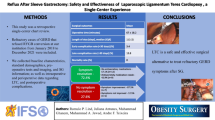Abstract
Background
Endoscopic sphincterotomy (EST) is the standard treatment for biliary duct stones. However, performing additional cholecystectomy after EST is controversial. In this study, we aimed to evaluate the effects of cholecystectomy after EST.
Methods
Between December 2008 and July 2011, we performed a prospective, randomized, single-center trial in 90 patients with proven gallstones who underwent EST and stone extraction. After the procedure, patients were randomly allocated to undergo cholecystectomy (n = 45) or to the group of GB left in situ (n = 45). The primary outcome was biliary complications at follow-up.
Results
Cholecystectomy was performed in 26 patients (60.5 %) in cholecystectomy group and in 13 patients (28.9 %) in intended conservative group. The median follow-up was 41 months. An intention-to-treat analysis showed that 8 patients (18.6 %) in the cholecystectomy group and 9 (20.0 %) in those who had their GB left in situ had recurrent biliary events (Kaplan–Meier curve, Breslow test, p = 0.555). In an as-treated analysis, 4 patients (10.3 %) who underwent cholecystectomy and 13 patients (26.5 %) who did not undergo cholecystectomy had additional biliary events during the follow-up period (Log-rank, p = 0.037). However, additional biliary events of cholangitis were similar in the two groups, except for a case of cholecystitis (Log-rank, p = 0.998).
Conclusions
Cholecystectomy after EST for biliary duct stones fails to reduce additional recurrent cholangitis but reduces additional cholecystitis.


Similar content being viewed by others
References
Ando T, Tsuyuguchi T, Okugawa T, Saito M, Ishihara T, Yamaguchi T, Saisho H (2003) Risk factors for recurrent bile duct stones after endoscopic papillotomy. Gut 52:116–121
Sugiyama M, Atomi Y (2002) Risk factors predictive of late complications after EST for bile duct stones: long-term (more than 10 years) follow-up study. Am J Gastroenterol 97:2763–2767
Costamagna G, Tringali A, Shah SK, Mutignani M, Zuccala G, Perri V (2002) Long-term follow-up of patients after EST for choledocholithiasis, and risk factors for recurrence. Endoscopy 34:273–279
Tanaka M, Takahata S, Konomi H, Matsunaga H, Yokohata K, Takeda T, Utsunomiya N, Ikeda S (1998) Long-term consequence of EST for bile duct stones. Gastrointest Endosc 48:465–469
Prat F, Malak NA, Pelletier G, Buffet C, Fritsch J, Choury AD, Altman C, Liguory C, Etienne JP (1996) Biliary symptoms and complications more than 8 years after EST for choledocholithiasis. Gastroenterology 110:894–899
Lau JY, Leow CK, Fung TM, Suen BY, Yu LM, Lai PB, Lam YH, Ng EK, Lau WY, Chung SS, Sung JJ (2006) Cholecystectomy or GB in situ after EST and bile duct stone removal in Chinese patients. Gastroenterology 130:96–103
Boerma D, Rauws EA, Keulemans YC, Janssen IM, Bolwerk CJ, Timmer R, Boerma EJ, Obertop H, Huibregtse K, Gouma DJ (2002) Wait-and-see policy or laparoscopic cholecystectomy after EST for bile-duct stones: a randomised trial. Lancet 360:761–765
Lai KH, Lin LF, Lo GH, Cheng JS, Huang RL, Lin CK, Huang JS, Hsu PI, Peng NJ, Ger LP (1999) Does cholecystectomy after EST prevent the recurrence of biliary complications? Gastrointest Endosc 49:483–487
Tazuma S (2006) Gallstone disease: epidemiology, pathogenesis, and classification of biliary stones (common bile duct and intrahepatic). Best Pract Res Clin Gastroenterol 20:1075–1083
Hazzan D, Geron N, Golijanin D, Reissman P, Shiloni E (2003) Laparoscopic cholecystectomy in octogenarians. Surg Endosc 17:773–776
Brunt LM, Quasebarth MA, Dunnegan DL, Soper NJ (2001) Outcomes analysis of laparoscopic cholecystectomy in the extremely elderly. Surg Endosc 15:700–705
Bingener-Casey J, Richards ML, Strodel WE, Schwesinger WH, Sirinek KR (2002) Reasons for conversion from laparoscopic to open cholecystectomy: a 10-year review. J Gastrointest Surg 6:800–805
Tsai TJ, Lai KH, Lin CK, Chan HH, Wang EM, Tsai WL, Cheng JS, Yu HC, Chen WC, Hsu PI (2012) The relationship between GB status and recurrent biliary complications in patients with choledocholithiasis following endoscopic treatment. J Chin Med Assoc 75:560–566
Ohashi A, Tamada K, Wada S, Hatanaka H, Tomiyama T, Tano S, Nakazawa K, Sugano K (2009) Risk factors for recurrent bile duct stones after endoscopic papillary balloon dilation: long-term follow-up study. Dig Endosc 21:73–77
Carey MC (1993) Pathogenesis of gallstones. Am J Surg 165:410–419
Tsai WL, Lai KH, Lin CK, Chan HH, Lo CC, Hsu PI, Chen WC, Cheng JS, Lo GH (2005) Composition of common bile duct stones in Chinese patients during and after EST. World J Gastroenterol 11:4246–4249
Bergman JJ, van der Mey S, Rauws EA, Tijssen JG, Gouma DJ, Tytgat GN, Huibregtse K (1996) Long-term follow-up after EST for bile duct stones in patients younger than 60 years of age. Gastrointest Endosc 44:643–649
Disclosures
Jun Heo, Min Kyu Jung, and Chang Min Cho have no conflicts of interest or financial ties to disclose.
Author information
Authors and Affiliations
Corresponding author
Electronic supplementary material
Below is the link to the electronic supplementary material.
Rights and permissions
About this article
Cite this article
Heo, J., Jung, M.K. & Cho, C.M. Should prophylactic cholecystectomy be performed in patients with concomitant gallstones after endoscopic sphincterotomy for bile duct stones?. Surg Endosc 29, 1574–1579 (2015). https://doi.org/10.1007/s00464-014-3844-8
Received:
Accepted:
Published:
Issue Date:
DOI: https://doi.org/10.1007/s00464-014-3844-8




